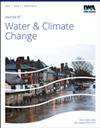Ecological flow research and optimal selection of the most ecologically relevant hydrologic indicators at the Jingjiang River's three outlets
IF 3.1
4区 环境科学与生态学
Q2 WATER RESOURCES
引用次数: 0
Abstract
Abstract Scientific ecological hydrological indicators provide constraints that contribute to the healthy operation and restoration of river ecosystems. Daily flow data from three Jing River outlets (SongZiKou (SZK), TaiPingKou (TPK), and OuChiKou (OCK)) spanning 1955–2019 were used. We employed innovative methods, such as IHA–RVA and annual distribution, to establish ecological flow thresholds. Surplus and deficit indicators were used to analyze annual and seasonal runoff dynamics. The PCA/RVA method identified relevant hydrological indicators and assessed hydrological changes influenced by the Three Gorges Reservoir (TGR). Key findings include suitable ecological flow thresholds for the flood season (SZK/TPK/OCK – 218.6/94.5, 51.7/96.0, and 60.9–4,494.5 m3/s, respectively). The TGR impacted the flow duration curve, causing deficits during the flood season (up to 0.99, OCK) and surpluses in non-flood seasons (up to 5.04, OCK). The study assessed the Jing River watershed's response to hydrological changes, notably due to the reservoir's water storage and flow interruption during the dry season, revealing declining low pulse count (SDG) and duration (MTS) and increasing high pulse duration (GJP). This research employs innovative methods and hydrological indicators, enhancing understanding of Jing River watershed ecological hydrology, and offering essential data for water resource management and ecosystem health.荆江三口生态流量研究及最具生态相关性水文指标优化选择
科学的生态水文指标为河流生态系统的健康运行和恢复提供了约束条件。使用了1955-2019年靖江三个口(松子口(SZK)、太平口(TPK)和瓯池口(OCK))的日流量数据。采用IHA-RVA和年分布等方法建立生态流量阈值。盈余和赤字指标用于分析年度和季节径流动态。采用PCA/RVA方法识别相关水文指标,评价三峡库区水文变化。主要发现包括汛期适宜的生态流量阈值(SZK/TPK/OCK - 218.6/94.5、51.7/96.0和60.9-4,494.5 m3/s)。三峡水库对流量持续时间曲线产生影响,在汛期造成亏损(0.99,OCK),在非汛期造成盈余(5.04,OCK)。研究评估了荆河流域对水文变化的响应,特别是由于水库蓄水和枯水期中断,发现低脉冲数(SDG)和持续时间(MTS)下降,高脉冲持续时间(GJP)增加。本研究采用创新的水文指标和方法,增强了对泾河流域生态水文的认识,为水资源管理和生态系统健康提供了重要数据。
本文章由计算机程序翻译,如有差异,请以英文原文为准。
求助全文
约1分钟内获得全文
求助全文
来源期刊

Journal of Water and Climate Change
WATER RESOURCES-
CiteScore
4.80
自引率
10.70%
发文量
168
审稿时长
>12 weeks
期刊介绍:
Journal of Water and Climate Change publishes refereed research and practitioner papers on all aspects of water science, technology, management and innovation in response to climate change, with emphasis on reduction of energy usage.
 求助内容:
求助内容: 应助结果提醒方式:
应助结果提醒方式:


